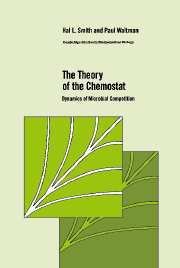Book contents
- Frontmatter
- Contents
- Preface
- 1 The Simple Chemostat
- 2 The General Chemostat
- 3 Competition on Three Trophic Levels
- 4 The Chemostat with an Inhibitor
- 5 The Simple Gradostat
- 6 The General Gradostat
- 7 The Chemostat with Periodic Washout Rate
- 8 Variable-Yield Models
- 9 A Size-Structured Competition Model
- 10 New Directions
- 11 Open Questions
- Appendices
- References
- Author index
- Subject index
11 - Open Questions
Published online by Cambridge University Press: 07 December 2009
- Frontmatter
- Contents
- Preface
- 1 The Simple Chemostat
- 2 The General Chemostat
- 3 Competition on Three Trophic Levels
- 4 The Chemostat with an Inhibitor
- 5 The Simple Gradostat
- 6 The General Gradostat
- 7 The Chemostat with Periodic Washout Rate
- 8 Variable-Yield Models
- 9 A Size-Structured Competition Model
- 10 New Directions
- 11 Open Questions
- Appendices
- References
- Author index
- Subject index
Summary
In this brief final chapter we collect in one place the main questions that remain unanswered concerning the models explored in this work. We proceed more or less in the order of the chapters. In many cases, the open problems mentioned here have already been identified and discussed in the discussion section of the corresponding chapter, so the reader may wish to check there as well.
As noted in the discussion section of Chapter 2, there remains a gap in our knowledge of the basic chemostat model in the case of differing removal rates for the competitors. The principal open problem is to extend the result of [Hsu1], described in Section 4 of Chapter 2, to general monotone uptake functions. It would also be desirable to include the class of not necessarily monotone uptake functions identified in [BWo1]. The recent work [WLu] represents a major step in this direction.
In Chapter 3, two limit cycles played a prominent role. The first occurred in the planar system, representing oscillations in the simple food chain. Neither the stability nor the uniqueness of the limit cycle was established. Kuang [K1] shows that the limit cycle is unique and asymptotically stable – for parameter values near where the rest point loses stability – by examining the Hopf bifurcation from the rest point. For other values of parameters, the uniqueness and stability questions remain open.
The second limit cycle was obtained as a simple bifurcation from the first limit cycle.
- Type
- Chapter
- Information
- The Theory of the ChemostatDynamics of Microbial Competition, pp. 248 - 252Publisher: Cambridge University PressPrint publication year: 1995

